Music Theory
This is a dump of random music theory notes for my personal study.
Chords
Chord symbols
| Type | Symbols | Examples |
|---|---|---|
| Major | M, Maj, △ | Cmaj9 (C E G B D) |
| Minor | m, Min, - | Cmin9 (C E♭ G B♭ D) |
| Dominant 7th | 7, dom7 | C9 (C E G B♭ D) |
| Half-Dimished | m7♭5, ø | Cm7♭5 (C E♭ G♭ B♭) |
| Diminished | dim, °, °7 | Cdim7 (C E♭ G♭ B♭♭) |
| Augmented | aug, +, 7♯5 | Caug7 (C E G♯ B♭) |
| Suspended Chords | sus | Replaces the 3rd.
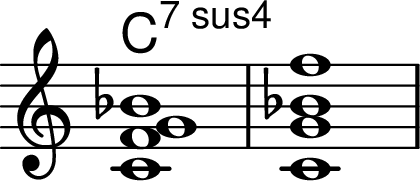 |
| Add Chords | add | Cadd2 (C D E G), Cadd9 (C E G D) |
| 6th chords | 6 | C6 (C E G A) |
| Slash chords | / | Denotes the chord to be played above which note.
Eg: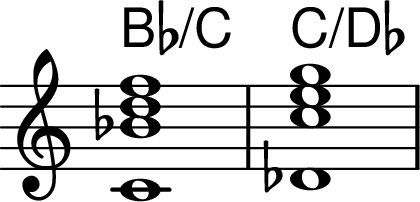 |
| 11th chords | 11 | May include 9 or not. |
| 13th chords | 13 | Usually 9th played below 13th |
Roman numerals
Roman numerals are used to denote chords. They are written with the following rules:
- Major chords are upper case. Eg. I, IV, V.
- Minor chords are in lower case. Eg. i, iv, v.
- Secondary dominant chords may be written with an 'x' suffix. Eg. IIx
Chord progressions are typically written in roman numerals so that they can be applied to any key.
Some theory about chords
- I chord is the tonic.
- V chord is the dominant
- IV is the subdominant.
The dominant chord resolves naturally back to its tonic. This resolution is called a perfect cadence.
Diminished chords
Symbol mnemonic: Remember that the diminished chord is denoted using the circle symbol. Slice it in half (ø) to get half diminished.
A diminished chord is using a stack of minor thirds. It's the chord that gets you 4 chords for the price of one because a diminished chord in one key is also the same for 3 other keys. For example, C°7 (C E♭ G♭ B♭♭) is the same as E♭°7 G♭°7 and A°7.
All 12 keys can fall into one of these three unique diminished chords:
| Equivalent Diminished Chords | Notes in this chord | ||||
|---|---|---|---|---|---|
| 1st | 2nd | 3rd | 4th | Based on 1st chord | Simplified notes |
| C°7 | E♭°7 | G♭°7 | A°7 | C E♭ G♭ B♭♭ | C E♭ G♭ A |
| D♭°7 | F♭°7 | A♭♭°7 | C♭♭ | D♭ F♭ A♭♭ C♭♭ | D♭, E, G, B♭ |
| D°7 | F°7 | A♭°7 | C♭°7 | D F A♭ C♭ | D F A♭ B |
Chord voicings
Rules of thumb:
- Don't repeat notes
- Root, 3rd, 7th are voiced in the lower register. Bass notes carry more weight and these notes are most important to a chord
- Give melody space. The melody should be a minor 3rd or greater away from chords to avoid muddying it.
- Play the chord in an inversion such that the top note is the same as the melody.
Shell voicing
A 3 note voicing with just the root, 3rd, and 7th. Root note should always be at the bottom of the chord (can be played with left hand). The 3rd and 7th can be swapped.
Examples of a C7 in a shell voicing in 2 different positions: (1 7 3; 1 3 7)
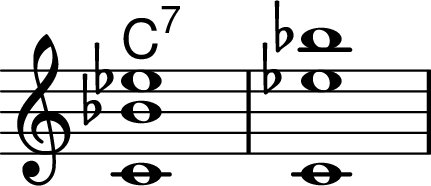
Open voicing
A 4 note voicings using the root, 3rd, 5th, and 7th. Rather than playing the chord in the specific order of 1 3 5 7 (i.e. a closed voicing), we may play it with notes out of order in a wider range across both hands.
Examples of a CMaj7 in an open voicing in 3 different positions: (1 5 3 7; 1 5 7 3; 1 7 5 3)
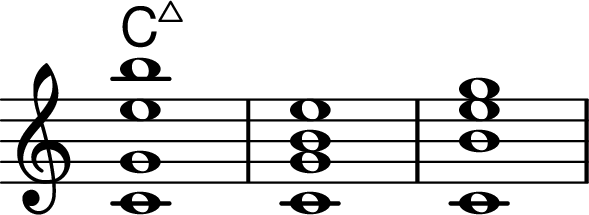
Rootless voicing
Popular in Jazz. Does not contain the root in the chord as it can be left to a bassist to play. Stacks of 3rds starting from the 3rd degree up to the 9th.
Examples of a CMaj7 in rootless voicing.
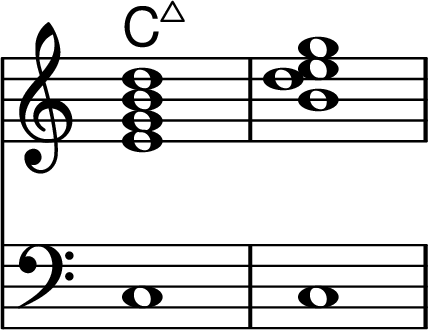
Quartal voicing
A quartal voicing is a type of chord voicing that is based on stacking 4ths above each note in the chord. This creates a different, more open and harmonically rich sound. It is also an ambiguous chord since it may match multiple different chords.
Quartal chords typically have 5 notes near the middle of the register, but it could also range from anything between 3 - 6 notes.
Example chord: E A D G C. (Could be C69, FMaj13, Am11, Dsus9, BbMaj13#11, depending on context). So What chord voicing is quartal chords but in the first inversion (A D G C E)
Here are some generic voicings.
| Example in C | Notes | |
|---|---|---|
| C69 | E A D G C | The root at the top |
| CMaj9 | B E A D G | Get rid of the root and play a B with the 5th on top |
| Dm11 | A D G C F | 3rd on top |
| G9 | B F A D G | Dominant voicing. Note B - F is a tritone (augmented 4th) and F - A is a major third (diminished 4th) |
| G13 | F B E A D | Dominant voicing. Note F - B here is also a tritone (augmented 4th) |
E A D G C - C69. The root at the top
B E A D G - CMaj9. Get rid of the root and play a B with the 5th on top
A D G C F - Dm11. 3rd on top
Quartal ii-V-I is possible. Eg: Dm11 - G9 - CMaj9 (ADGCF BFADG BEADG) or Dm11 - G13 - C69 (ADGCF FBEAD EADGC)
13 voicing
b7 3 13 9 5
minor 11
1 5 9 b3 11 b7
Learning a voicing in all keys
- Play the voicing
- Move it up snd down by a half step
- Move it up and down by whole steps
- Move it up and down in minor third steps
- Move it up and down in major thirds
Chord notes
Chord tones
Chord tones are the 1 and 5th notes of the chord.
Guide tones
Guide tones are notes in the chord that captures the 'essence' of the chord. The notes that are typically of interest are usually the 3rd, 7th, and extended keys 9th, 11th, and 13th. We use these guide tones to build smooth lines of notes rather than jumpy chords to complement the melody. The main melody should target one of these guide tones for it to sound coherent.
We focus on the 3rd and 7th here because if we progress our chord through the circle of fifths, then the 3rd and 7th guide tones will swap.
| Key | Major | Dom7 | Minor/ø | Major 7, Dominant 7, Minor 7, Half-Diminished, and Diminished | |||
|---|---|---|---|---|---|---|---|
| 3 | 7 | 3 | 7 | 3 | 7 | ||
| C | E | B | E | B♭ | E♭ | B♭ |  |
| F | A | E | A | E♭ | A♭ | E♭ |  |
| B♭ | D | A | D | A♭ | D♭ | A♭ |  |
| E♭ | G | D | G | D♭ | G♭ | D♭ |  |
| A♭ | C | G | C | G♭ | C♭ | G♭ |  |
| D♭ | F | C | F | C♭ | F♭ | C♭ |  |
| G♭ | B♭ | F | B♭ | F♭ | B♭♭ | F♭ |  |
| B | D♯ | A♯ | D♯ | A | D | A |  |
| E | G♯ | D♯ | G♯ | D | G | D |  |
| A | C♯ | G♯ | C♯ | G | C | G |  |
| D | F♯ | C♯ | F♯ | C | F | C |  |
| G | B | F♯ | B | F | B♭ | F |  |
Notes past the 7th are also known as chord extensions.
Available tensions
Extended keys above the 7th that are not avoid notes are referred to as available tensions. These include the 9th, 11th, 13ths (which maps to the 2nd, 4th, 6th degree, but are played beyond the 7th in this context. Otherwise, if they're played below the 7th, they'd just be called add chords instead.)
Notes on the 9th chord:
Typically extensions are natural. So the 9th chord would typically be the natural 9 (or the 2nd degree but an octave higher) that's built on top of the existing chord (be it a dominant or major chord). Therefore:
- A dominant ninth is the combination of a dominant chord (with a minor seventh) and a major ninth.
- A major ninth chord (e.g., Cmaj9), as an extended chord, adds the major seventh along with the ninth to the major triad. Cmaj9 consists of C, E, G, B and D
Avoid notes
Avoid notes are notes that are one semitone above/below a chord tone. Eg. CMaj13 has C E G B D F A, but F is an avoid note because it's 1 semitone above the E.
When playing CMaj13, it's typical to skip the 11th (F) when playing the chord.
Avoid notes should be used to create dissonance which you can then resolve later.
Chord progressions
Some common chord progressions include:
| Minor | Major |
|---|---|
| 1-6-2-5 | 1-6-2-5
I – vi – ii – V |
| 1-4-3-5 | 1-5-6-4
I-V-vi-IV |
| 1-6-4-5
i-vi-iv-V |
1-6-4-5
I-vi-IV-V |
| 1-7-6-5 | 1-4
I-IV and I-IV-V |
| 1-7 | 1-5sus |
| Keys: Am, Dm, Em, Gm, Cm | Keys: C F G Bb, Eb |
12 bar blues
There are a few variations of the 12 bar blues. For typical jazzy music, it goes as follows:
I - IV - I - I
IV - IV - I - I
V - IV - I - I
1-7-6-5 / i - VII - VI - V7
- Hit the road jack
- why don't you do right?
Circle of fifths
Chord progressions built on a partial circle of fifths.
Variants include partial circle of fifths such as:
- ii - V7 - I
- iii VI7 ii V7 I
My funny valentine
- Em/E Em/Eb Em/D Em/Db C7 B7 (repeat)
1-6-2-5 / I - VI7 - ii7 - V7
- I got rhythm
- Every jazz song
Variants:
- I – vi – ii – V
1-6-4-5 / I - vi - IV - V
- Heart and soul
Variants:
- I – vi – IV – V
1-5-6-4 / I - V - vi - IV
- four chord pop song
- I – IV – V – IV
- vi – IV – I – V
- I – IV – ii – V
- I – IV – I – V
- I – ii – iii – IV – V
- I – III – IV – iv
- i – V – i – iv
- vi – V – IV – III Andalusian Cadence
ii-V-I
Here is the ii-V-I chord progression in all 12 keys.
If you are practicing the ii-V-I over and over, you can try the ii-V-I-VI (eg. Dm7 G7 Cmaj7 A7) which nicely loops back on itself.
Tip: Replace the minor ii chord with a half diminished (ø) chord to get the minor variant of the ii-V-I progression. You may want to alter the V7 chord and flatten the 9th to make it sound better.
| Key | ii (supertonic) | V (dominant) | I (tonic) | Preview |
|---|---|---|---|---|
| C major | Dm7 | G7 | Cmaj7 |  |
| F major | Gm7 | C7 | Fmaj7 |  |
| B♭ major | Cm7 | F7 | B♭maj7 |  |
| E♭ major | Fm7 | B♭7 | E♭maj7 |  |
| A♭ major | B♭m7 | E♭7 | A♭maj7 |  |
| D♭ major
C♯ major |
E♭m7
D♯m7 |
A♭7
G♯7 |
D♭maj7
C♯maj7 |
 |
| G♭ major
F♯ major |
A♭m7
G♯m7 |
D♭7
C♯7 |
Gbmaj7
F♯maj7 |
 |
| C♭ major
B major |
D♭m7
C♯m7 |
G♭7
F♯7 |
C♭maj7
Bmaj7 |
 |
| E major | F♯m7 | B7 | Emaj7 |  |
| A major | Bm7 | E7 | Amaj7 |  |
| D major | Em7 | A7 | Dmaj7 |  |
| G major | Am7 | D7 | Gmaj7 |  |
I-bVII-IV
Classic rock sound which comes from the Mixolydian mode.
I-IV-V
It’s impossible to navigate the world of Western music without bumping into this progression. It shows its face in rock, pop, country, Blues, classical, and jazz. It sounds incredibly pleasing to the ear, and you’d be hard-pressed to find a more harmonically solid sequence of chords.
C major: C-F-G
D♭ major: D♭-G♭-A♭
D major: D-G-A
E♭ major: E♭-A♭-B♭
E major: E-A-B
F major: F-B♭-C
F♯ major: F♯-A♯-C
G major: G-C-D
A♭ major: A♭-D♭-E♭
A major: A-D-E
B♭ major: B♭-E♭-F
B major: B-E-F♯
I-V-vi-IV
C major: C-G-Am-F
D♭ major: D♭-A♭-B♭m-G♭
D major: D-A-Bm-G
E♭ major: E♭-B♭-Cm-Ab
E major: E-B-C♯m-A
F major: F-C-Dm-B♭
F♯ major: F♯-C♯-D♯m-B
G major: G-D-Em-C
A♭ major: A♭-E♭-Fm-D♭
A major: A-E-F♯m-D
B♭ major: B♭-F-Gm-E♭
B major: B-F♯-G♯m-E
Chord substitution
Chord substitutions can be done to color the music or add different harmonic context to an improvisation.
There are a few ways to substitute chords.
- Diatonic substitution: Replace an existing chord with another chord within the diatonic key center.
- In other words, substitute a chord with another chord within the diatonic scale (that is: ii, iii, iv, V, vi, vii°)
- For example, if you are in the key of C using a 1-6-2-5 progression, you could instead try a 3-6-2-5 which resolves back to the 1.
- Secondary dominant: Replace an existing chord with a dominant 7th that tonicizes the next chord.
- For example, with a 1-6-2-5 in C: Cmaj7, Amin7, Dmin7, G7.
- We can replace the 6 chord with a A7. A7 is a dominant V chord of Amin7. The A7 becomes 'the V of ii'.
- We can go further and replace the 2 chord with a D7 which becomes the dominant V chord of G7. 'the V of V'
- Diminished dominant:
- Simple way of doing this is to play a diminished 7th chord of the 3rd.
- Backdoor dominant: Substitute a V chord for a dominant 7 that is a whole step below the chord you are arriving to.
- Tritone substitution: Substitute a dominant 7th chord with another diatonic chord in the key that is a tritone away.
- For example, with a 1-6-2-5 in C: Cmaj7, Amin7, Dmin7, G7:
- The V chord (G7) can be replaced with (tritone away from G7 is C#/Db) a Db7 chord.
- The 6 chord (Amin7) can be replaced with a A7 (using secondary dominant) which makes it the V of ii. We can then replace the A7 with (tritone away from A7 is Eb) a Eb7 chord. 'tritone sub of vi'
- For example, with a 1-6-2-5 in C: Cmaj7, Amin7, Dmin7, G7:
Scales
Pentatonic scales contain 5 notes (hence 'penta' in its name).
Major pentatonic scale
The five notes in the major pentatonic scale is formed by leaving the 4th and 7th from a regular scale.
Embellishments that you may add when improvising in this scale:
- Add a grace note on either 2 or b3 in front of the third of the scale.
- To add harmony: add 5 above 2 or 3; add R above 5 or 6
Noah Kellman notes
- 1 b3 4 5 b7
A basic pentatonic voicing:
- 1 11 b7 b3 5
To get a so-what voicing, move this up by one step
Other voicings for this key is done by moving each of the 4 keys up to the next note in the pentatonic scale
Circle of fifths
The circle of fifths is a series of chord changes in a perfect cadence (V - I). It may also be referred to the circle of fourths by some theory books since moving up from I to V is the same as going up a fourth.
E - A - D - G - C - F - Bb - Eb - Ab - Db - F# - B
Modes
At the most basic level, modes are basically just different types of scales. The most common and familiar mode would be the Ionian mode which is another name for the major scales.
Below are the modes, grouped by their family.
Major modes
There are 7 major modes. These modes can be broken down further into 2 groups: The brighter modes a major 3rd and the darker modes that have a minor 3rd.
| # | Mode name(s) | Degrees | Steps | Chord Compatibility | Notes |
|---|---|---|---|---|---|
| 1 | Ionian
Major |
1 2 3 4 5 6 7 | 1-1-½-1-1-1-½
|
△, 6, △7, △9, 6/9, △13 | Has major 2nd, 3rd, 6th, and 7th.
Improv on any diatonic chord and major chords. |
| 2 | Dorian | 1 2 ♭3 4 5 6 ♭7 | 1-½-1-1-1-½-1
|
min, min7, min9, min11, min6, m6/9 | Stacks of perfect 5ths; no tritones
Has a minor 3rd and perfect 5th, major 6th. Improv over a minor-1 (i) and major-4 (IV) which suggests haunting, uncertain, longing or sadness. |
| 3 | Phrygian | 1 ♭2 ♭3 4 5 ♭6 ♭7 | ½-1-1-1-½-1-1
|
min, m7 | Has a minor 3rd and perfect 5th.
Use ♭2 as a passing tone as it causes dissonance with root. Improv over the i-iv-♭II-i chord progression. |
| 4 | Lydian | 1 2 3 #4 5 6 7 | 1-1-1-½-1-1-½
|
△, 6, △7, △9, 6/9, △13 | The mode with a sharp 4.
Has major 2nd, 3rd, 6th, 7th. Improv on 1-chord and 2-chord. |
| 5 | Mixolydian | 1 2 3 4 5 6 ♭7 | 1-1-½-1-1-½-1
|
7, 9, 13, sus4 | The mode with the flat 7.
Has major 2nd, 3rd, 6th. The flat 7 makes it ideal for dominant chords. Improv with the mixolydian scale using I-♭VII-IV. 4th is an avoid note (clashes with 3) but can be used to create tension that resolves to the major of the 4th. Similar to Lydian Dominant (but with a natural 4) |
| 6 | Aeolian
Natural minor |
1 2 ♭3 4 5 ♭6 ♭7 | 1-½-1-1-½-1-1
|
min, min7, min9, min11 | Natural minor scale
Has a minor 3rd and perfect 5th. Do not use chord voicings containing ♮6 (such as m13, m6) Improv with minor-1 (i) and minor 4 (iv) chord. |
| 7 | Locrian | 1 ♭2 ♭3 4 ♭5 ♭6 ♭7 | ½-1-1-½-1-1-1
|
dim (°) triad, ø7, min11, ø11. | Only mode to contain a diminished 5th.
Improv over ø7-bII-♭ii |
Melodic minor modes
Melodic minor modes are built from the jazz melodic minor scale. Note that the melodic minor scale used here is the 'jazz' version where it's the same keys ascending as descending (ie. a major scale with a minor third). This is unlike the classical version where there's a flat 6 only when descending (the natural minor scale, which is a mode of the major scale).
Overview of each mode is given in the table below.
| # | Mode name(s) | Degrees | Steps | Chord Compatibility | Notes |
|---|---|---|---|---|---|
| 1 | Altered
Super locrian Ionian #1 Locrian b4 scale Diminished Wholetone |
1 ♭2 ♭3 ♭4 ♭5 ♭6 ♭7 | ½-1-½-1-1-1-1
|
7alt
mi7♭5 |
Use On: dominant chords with altered tensions, also see The Altered Scale |
| 2 | Ascending melodic minor
Jazz melodic minor scale Dorian #7 |
1 2 ♭3 4 5 6 7 | 1-½-1-1-1-1-½
|
minor
mi-maj7 |
Play this mode when used over: minor chords, min/maj7 chords |
| 3 | Dorian b2
Phrygian #6 |
1 ♭2 ♭3 4 5 6 ♭7 | ½-1-1-1-1-½-1
|
m7 | phrygian chord; substitutes dom chord
Play this mode when used over: Dom7+susb9 |
| 4 | Lydian Augmented
Lydian #5 |
1 2 3 #4 #5 6 7 | 1-1-1-1-½-1-½
|
Ma7#5 | #5, hence augmented
Play this mode over: Maj |
| 5 | Lydian Dominant
Lydian b7 Overtone scale Mixolydian #4 |
1 2 3 #4 5 6 ♭7 | 1-1-1-½-1-½-1
|
7 | Like Mixolydian but with a #4.
Play this mode when used over: Dom7+#11 |
| 6 | Aeolian dominant
Mixolydian b6 Mixolydian b13 scale Hindu scale |
1 2 ♭3 4 ♭5 ♭6 ♭7 | 1-1-½-1-½-1-1
|
7 | use altered scale or whole tone scale instead
Play this mode when used over: dominant 7♭13 chords (this type of usage is rarer) |
| 7 | Half Diminished
Locrian ♮/#2 Aeolian b5 |
1 2 ♭3 4 ♭5 ♭6 ♭7 | 1-½-1-½-1-1-1
|
ø | Play this mode when used over: m7♭5 (ø) chords |
In the case of C minor: Note that you can improve using the associated mode over the listed chord.
| # | Mode name | Degrees | Notes with Cm | Chord | Notes |
|---|---|---|---|---|---|
| 1 | Jazz melodic minor scale | 1 2 b3 4 5 6 7 | C D Eb F G A B | CmMaj7 | improv this scale over <- chord |
| 2 | Dorian b2 | 1 b2 b3 4 5 6 b7 | D Eb F G A B C | Dm7+b9
Dsusb9 (phrygian) |
|
| 3 | Lydian Augmented | 1 2 #4 #5 6 7 | Eb F G A B C D | EbMaj7#5 | |
| 4 | Lydian Dominant | 1 2 3 #4 5 6 b7 | F G A B C D Eb | F7#11 | |
| 5 | Mixolydian b6 | 1 2 3 4 5 b6 b7 | G A B C D Eb F | G7b13
CmMaj7/G |
Rare. Use the altered scale or whole-tone scale with these chords rather than melodic minor scale. |
| 6 | Half Diminished | 1 2 b3 4 b5 b6 b7 | A B C D Eb F G | Am7b5 | |
| 7 | Altered Scale | 1 b2 b3 b4 b5 b6 b7 | B C D Eb F G A | Bm7b5
B7alt (root - b4 - b7) |
Tips
Hand grips
The notes here are from Oliver Prehn (NewJazz)'s video on improvisation on all 12 keys. The idea here is to familiarize yourself with using a 3 finger hand grip to play all the different modes in all 12 keys.
The 3 finger hand grip for the right hand is created with:
- Your thumb on the base key
- Your 2nd finger on the minor 3rd and
- Your 3rd finger on the perfect 4th
The idea is to use this hand grip to lessen the mental load on determining which keys belong to which scale/modes to help improvisation.
Here are the different types of scales that were covered.
| Mode/Type | Example | Notes |
|---|---|---|
| Pentatonic | The G pentatonic:  |
A simple pentatonic scale can be achieved by repeating the 3 finger hand grip once per scale.
Note the second position is one whole step above the previous note. |
| Dorian | C dorian:  |
The dorian mode can be played with this 3 finger hand grip by following the same principle as the pentatonic scale above.
You will have to repeat this again one whole step up in order to hit all the keys in the dorian mode. |
C♭ dorian:  |
Use the same fingerings for all other keys. For example, we can shift everything up by a half step to get D♭ dorian. | |
| Lydian | C lydian mode:  |
Lydian mode can be done using the same hand grip but with different base locations. |
C lydian mode using 5 fingers:  |
You can also use a 5 finger hand grip (which the video calls the 'triad based grip') with 3 different positions. | |
F lydian:  |
Use the exact same fingering for other keys. | |
| Minor blues scale | G minor blues scale:  |
Like the pentatonic scale, but inject a chromatic step in the middle. |
| Major blues scale | G major blues scale: C major blues scale:  |
Same hand grip, but different location.
Note that the major blues scale doesn't start on the tonic note. Instead, we shift it down by a minor third so that our 2nd finger hits the tonic note. |
To play all the different modes, you'll use the exact same 3 finger hand grip at different bases.
| Mode/Type | Example in C | Notes |
|---|---|---|
| Ionian |  |
C Ionian. Bases are: D, A, E, B (2, 6, 3, 7)
Degrees, sorted are: 2, 3, 6, 7. Similar to Mixolydian |
| Dorian |  |
C Dorian. Bases are: C, G, D, A (1, 5, 2, 6)
Degrees, sorted are: 1, 2, 5, 6. Similar to Aeolian |
| Phrygian |  |
C Phrygian. Bases are: B♭, F, C, G (7, 4, 1, 5)
Degrees, sorted are: 1, 4, 5, 7. Similar to Locrian |
| Lydian |  |
C Lydian. Bases are: A, E, B, F♯ (6, 3, 7, 4)
Degrees, sorted are: 3, 4, 6, 7 |
| Mixolydian |  |
C Mixolydian. Bases are: G, D, A, E (5, 2, 6, 3)
Degrees, sorted are: 2, 3, 5, 6. Similar to Ionian |
| Aeolian |  |
C Aeolian. Bases are: F, C, G, D (4, 1, 6, 2)
Degrees, sorted are: 1, 2, 4, 6. Similar to Dorian |
| Locrian |  |
C Locrian. Bases are: E♭, B♭, F, C (3, 7, 4, 1)
Degrees, sorted are: 1, 3, 4, 7. Similar to Phrygian |
The same thing can also be done using the 5 finger hand grip. The modes below are ordered such that it shares at least one common degree with the previous mode.
| Mode/Type | Example in C | Notes |
|---|---|---|
| Ionian |  |
C Ionian. Bases are: C, G, D (1, 5, 2)
Degrees, sorted are: 1, 2, 5. Similar to Mixo, Lydian |
| Mixolydian |  |
C Mixolydian. Bases are: F, C, G (4, 1, 5)
Degrees, sorted are: 1, 4, 5. Similar to Dorian, Ionian |
| Dorian |  |
C Dorian. Bases are: B♭, F, C (7, 4, 1)
Degrees, sorted are: 1, 4, 7. Similar to Aeolian, Mixo |
| Aeolian |  |
C Aeolian. Bases are: E♭, B♭, F (3, 7, 4)
Degrees, sorted are: 3, 4, 7. Similar to Dorian, Phrygian |
| Phrygian |  |
C Phrygian. Bases are: A♭, E♭, B♭ (6, 3, 7)
Degrees, sorted are: 3, 6, 7. Similar to Locrian, Aeolian |
| Locrian |  |
C Locrian. Bases are: D♭, A♭, E♭ (2, 6, 3)
Degrees, sorted are: 2, 3, 6. Similar to Lydian, Phrygian |
| Lydian |  |
C Lydian. Bases are: G, D, A (5, 2, 6)
Degrees, sorted are: 2, 5, 6. Similar to Ionian, Locrian |
Stepwise hand grip
| Mode/Type | Example in C | Notes |
|---|---|---|
| Ionian |  |
Bases are D and A (2 and 6th) |
| Dorian |  |
Bases are C and G (1st and 5th) |
| Aeolian |  |
Bases are C and F (1 and 4th) |
| Phrygian |  |
Bases are F and B♭ (4 and 7th) |
| Locrian |  |
Bases are E♭ and B♭ (3 and 7th) |
| Mixolydian |  |
Bases are D and G (2 and 5th) |
| Lydian |  |
Bases are E and A (3 and 6th) |
Left hand grips?
When practicing, you can play just the tonic/root note as an octave.
For more complex chords, you may try using this hand grip where the spacings between the 4 notes are 3-1-4:
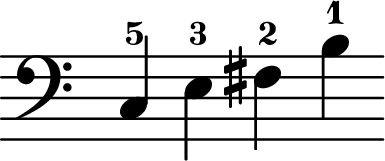
. When combined with any other cords using the 5 finger grip above, you could get some very complex chords. Some examples:
| Mode/Type | Example (play as a chord) |
|---|---|
| C Lydian Augmented |   |
| C Lydian Dominant | 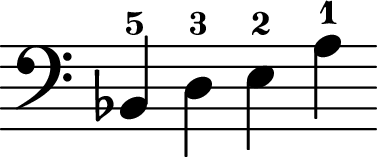  |
| C Aeolian Major |  |
| C Half diminished | 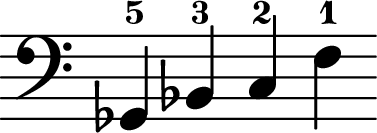  |
Shell chords
- Drop some notes from the chord while keeping the essence of the chord.
- Especially on lower registers.
- Try to keep the 3rd and 7th or a defining note of the chord (eg. 13th if that's what you're playing)
- Use inversions as needed to avoid jumping chords
Practice pieces
Practice tips when learning a new piece, (from How to Play Jazz Piano - Beginner to Advanced)
- Left hand 7th chords at root position on beat 1 and holding for the bar.
- Left hand 7th chords at root position & second inversion to get a smoother voice leading
- Create rhythmic interest by alternating by playing left hand 7th chords at beats 1 + 4 (or whatever sounds good?) rather than on the beat.
- Create a varying rhythm by comping the left hand chords.
- Replace the 7th chords with a walking bassline on every beat on left hand while continuing to playing the melody
- Add 7th chords with the right hand in between the melody
- Like #3 or #4 above, but with rootless chords in the left hand in between the melody.
- Like #5 with a walking bass line on every beat, but play the melody and rootless chords in between the melody with right hand.
- Two handed chords in between the melody and walking bassline.
When playing the melody which repeats again, you may choose to play it slightly differently to add additional interest. Try one of the following options:
- Embellish the melody
- Thicken the melody: Keep the melody as the top note but try to:
- Add sets of thirds and fourths; add only sixths; use triads; use octaves.
- Drone notes
Fly me to the moon
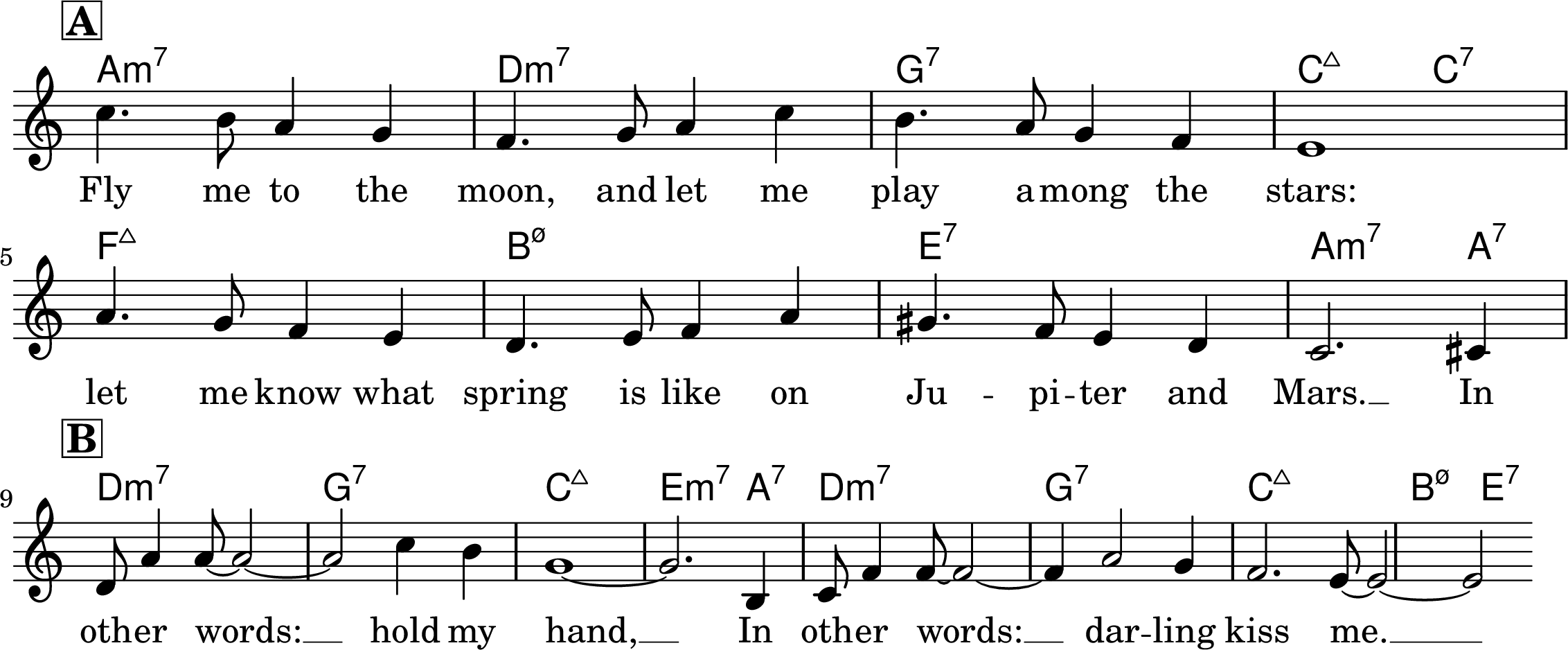
| Chord | Am7 | Dm7 | G7 | CMaj7 | C7 | FMaj7 | Bø | E7 | A7 |
|---|---|---|---|---|---|---|---|---|---|
| Guide Tones (3rd / 7th) | C G | F C | B F | E B | E B♭ | A E | D A | G♯ D | C# G |
| Rootless Chord + 9 | CMaj7 / A
C E G B |
FMaj7 / D
F A C E |
Bm7b5 / G
B D F A |
Emin7 / C
E G B D |
Em7b5 / C
E G B♭ D |
Amin7 / F
A C E G |
D F A C# | G#m7b5 / E
G♯ B D F♯ |
C#m7b5 / A
C# E G B |
| Quartal & Open Voice (L/R) | A D / C E G | A D / F A C | G D / B D F |
Note that:
- Minor 7 chord's rootless 9th becomes its 3rd major 7 chord
- Major 7 chord's rootless 9th becomes its 3rd minor 7 chord
- Dominant 7 chord's rootless 9th becomes its 3rd half diminished chord
- Not sure what diminished 7th gets you.
Autumn Leaves
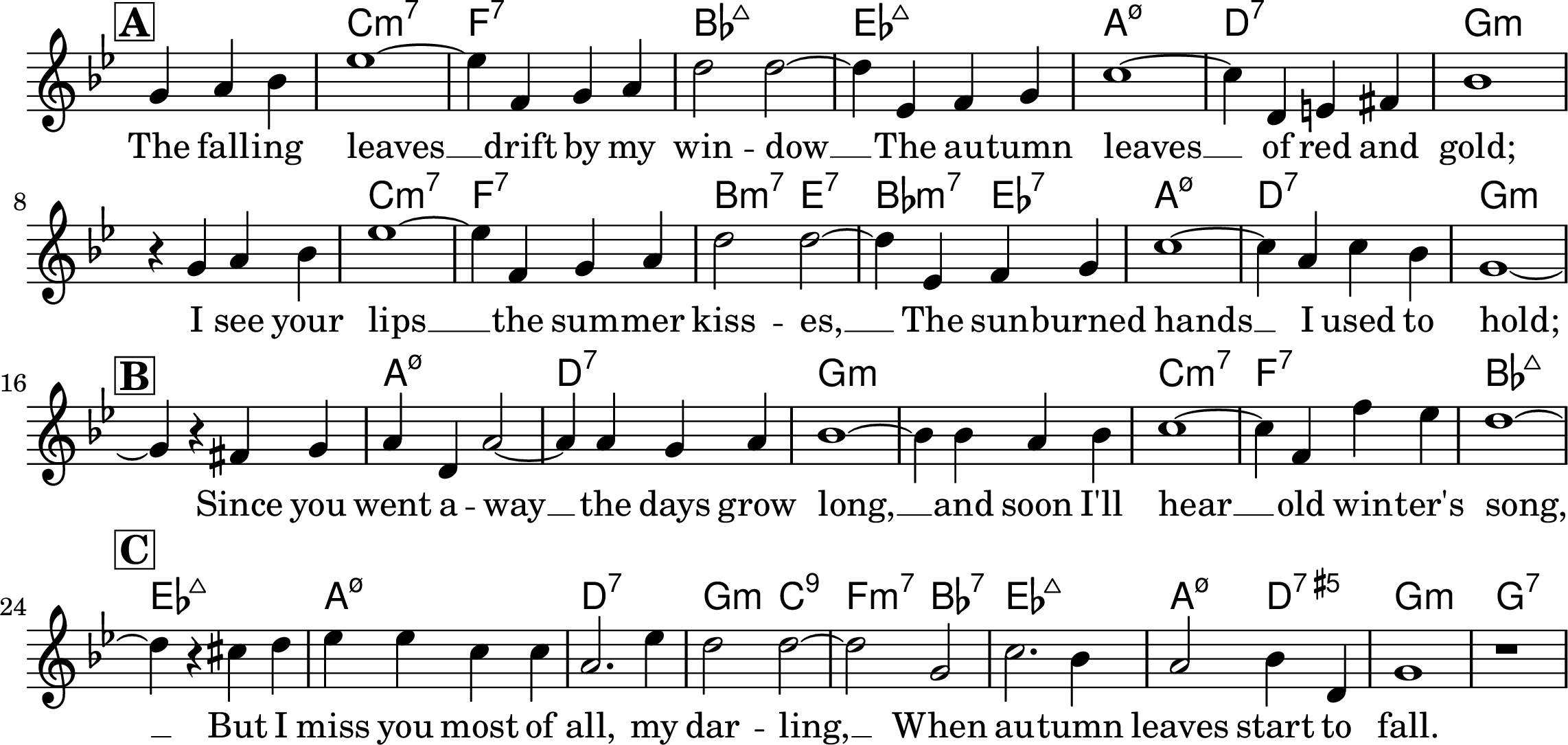
| Chord | Cm7 | F7 | B♭Maj7 | E♭Maj7 | Aø | D7 | Gm7 |
|---|---|---|---|---|---|---|---|
| Guide Tones (3rd / 7th) | E♭ B♭ | A E♭ | D A | G D | C G | F♯ C | B♭ F |
| Rootless Chord + 9 | E♭ G B♭ D | E♭ G A D | D F A C | D F G B♭ | C E♭ G B♭ | C E♭ F♯ A | B♭ D F A |
| Quartal & Open Voice (L/R) | C F / B♭ E♭ G | C F / A E♭ G | G C / F B♭ D | D G / C F A | E♭ A / D G C | E♭ A / D F#C | G D B♭ / C F A |
Rhythm: Vary the rhythm of the melody to make it swing and more syncopated. Start and end the melody on the off beat. Try to delay notes by half a beat.
When improvising, use the walking bass notes on the left hand and improvise using a mix of both the B♭ major scale and G blues scale on the right hand.
Take Five
Watermelon Man
Satin Doll
See also
- https://muted.io/cheat-sheet/ - Super helpful cheat sheet for chords and circle of fifths